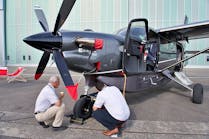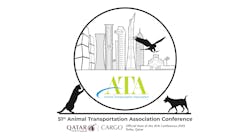Helicopter Association International Mourns the Passing of Industry Pioneer Elling Halvorson
Elling B. Halvorson, founder and chairman of the board of Papillon Grand Canyon Helicopters in Boulder City, Nevada, died Apr. 16, 2020, at the age of 88. With the opening of his helicopter tour company in 1965, he is credited with creating the site-specific helicopter tourism sector.
Halvorson was born in St. Paul, Minnesota, on Jan. 2, 1932. His father was in the construction business, and the Halvorsons moved from state to state for his work. After high school, Halvorson attended college in Iowa and Idaho before graduating from Oregon’s Willamette University with a degree in economics and “what you might call a minor in civil engineering,” as he said in a 2011 interview with ROTOR magazine.
Following college, Halvorson followed in his father’s footsteps and owned a construction company, one that specialized in geographically remote, difficult projects. In 1960, for one particularly challenging project for AT&T in the Sierra Nevada Mountains, Halvorson bought his first helicopter, a Bell 47G-3B-1, to ferry workers and light construction materials up and down the mountain.
But the project that spawned Papillon Helicopters in 1965, and its focus on providing aerial sightseeing tours, took place in the Grand Canyon, where Halvorson and his team used helicopters to help build a buried 13.5-mile water pipeline connecting the North and South Rims of the canyon. Traditional construction equipment at the time was too large for the project, so Halvorson designed and built many of the pieces of project’s excavation equipment.
Providing personnel, pipe sections, and other construction supplies to the remote parts of the project was part of Halvorson's construction plan, and he again determined that helicopters were the solution. Over the course of the project, Halvorson and his company used a variety of rotorcraft on the project. “We leased large helicopters. We had a Sikorsky S-61, a Bell 204B, and the Sikorsky S–55. We used all of those machines and a fleet of Bell 47G-3B-1s and Hiller SL-4s,” he recalled.
Nearing the end of the project, a massive flood destroyed most of the construction equipment and swept away nine miles of the completed pipeline. While surveying the damage in Bright Angel Canyon, near its entrance to the Colorado River at Phantom Ranch, Halvorson's helicopter struck a wire radio antenna. Halvorson sustained critical injuries in the crash, and his recovery took six months.
From the early stages of the pipeline project, the Grand Canyon had provided Halvorson, his crews, and visitors with an awe-inspiring backdrop. According to the History section on Papillon’s website, “as Halvorson and his team flew colleagues and clients to work sites within the canyon, the majestic scenery was so captivating that workers began requesting chartered helicopter flights during off hours. Halvorson recognized the golden opportunity that lay in front of him.”
To satisfy this new demand, he established Papillon, the first aerial sightseeing company to fly the Grand Canyon. The company now flies an estimated 600,000 tour passengers each year.
Innovation and safety were central to Halvorson's success. Throughout his career, he told HAI, Halvorson sought out the toughest, most unusual construction jobs that demanded innovative thinking to complete, including, in addition to the Grand Canyon pipeline, projects in the Arctic and the Aleutian Islands. “We were innovative from the beginning. With the challenges of each project being in a different geographical area, we grew more capable as time went on.”
Sensitive to the concerns of those visiting the Grand Canyon, Halvorson challenged the top helicopter manufacturers of the time to develop quieter aircraft. He developed the Whisper Jet helicopter, for which he created a muffler using passive noise cancellation as a noise-reduction technology.
In his 2011 ROTOR interview, Halvorson explained his success this way: “Confidence is an important element of being successful. However, together with self-confidence, it is necessary to have a business plan that will work.… We evaluate as carefully as we can the economics and business opportunities. Then we go into it full throttle.… Success is a process of working at something and tweaking it and improving it until it does work.”
Halvorson was a strong advocate of giving back to the helicopter industry. Ever the pioneer, he in 1986 cofounded the Tour Operators Program of Safety, a group bringing together air tour operators to develop operating standards and recommended safety practices that exceed regulatory requirements.
A long-time member of HAI, Halvorson served two terms as chairman of the association’s Board of Directors. He was also active in other organizations, including the National Business Aircraft Association, American Helicopter Society, National Parks Overflight Advisory Group, US Travel Association, and the US Air Tour Association. He was inducted into the Vertical Flight Hall of Fame as part of the 2016 Living Legends of Aviation Awards.
Halvorson was also dedicated to helping his community through donations and support for the Evergreen Hospital in Kirkland, Washington, where the Halvorson Cancer Center is located, as well as the Seattle Union Gospel Mission and the family’s nonprofit, the Halvorson Charities Fund.
Halvorson and his wife, Barbara, first met in high school and were married in 1953. Together, they had five children: Brenda, Kent, Lon, Randal, and Rodney, as well as eight grandchildren and 12 great-grandchildren. Brenda currently serves as CEO of Papillon Grand Canyon Helicopters and Grand Canyon Scenic Airlines, and Lon worked with his father in Papillon Helicopters and is CEO of Rainier Heli‑Lift International and several other entities doing heavy‑lift work.
No service information for Halvorson is currently available.

